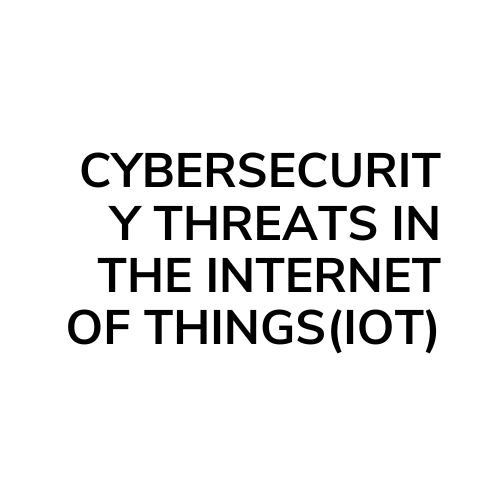Cybersecurity Threats in the Internet of Things(IOT)

The Internet of Things (IoT) refers to the network of interconnected devices that communicate and share data over the internet. While IoT technology offers numerous benefits, it also introduces several cybersecurity threats due to its interconnected nature and the proliferation of devices. Some of the prominent cybersecurity threats in the Internet of Things include:
- Weak Authentication and Authorization: Many IoT devices have default or weak passwords, making them vulnerable to unauthorized access. Attackers can exploit these vulnerabilities to gain control over the devices.
- Inadequate Security Updates and Patches: IoT devices often lack proper mechanisms for security updates and patches. Manufacturers might not consistently release updates or provide long-term support, leaving devices exposed to known vulnerabilities.
- Lack of Encryption: Data transmitted between IoT devices and servers may not always be encrypted, making it susceptible to interception and tampering by attackers.
- Privacy Concerns: IoT devices often collect a vast amount of personal data. If this data is not properly secured, it can be compromised, leading to privacy violations and potential misuse.
- Denial-of-Service (DoS) Attacks: IoT devices can be hijacked to launch large-scale DoS attacks, flooding networks or servers with excessive traffic and causing disruptions.
- Physical Security Risks: Some IoT devices, such as smart home appliances or industrial sensors, may have physical vulnerabilities that can be exploited by attackers to gain unauthorized access.
- Supply Chain Attacks: Attackers may compromise IoT devices during the manufacturing process or through the supply chain, implanting malware or backdoors that can be activated later.
- Botnets: Attackers can create botnets by infecting multiple IoT devices, controlling them remotely, and using them to execute coordinated attacks or perform malicious activities.
- Interoperability Issues: IoT devices from different manufacturers may not adhere to standardized security protocols, leading to interoperability issues that can be exploited by attackers.
- Insufficient User Awareness: Users may not be aware of the security risks associated with IoT devices or may not take necessary precautions, such as changing default passwords or updating firmware.
To mitigate these threats, it’s crucial to implement robust security measures at every stage of IoT device development, including encryption, regular security updates, strong authentication mechanisms, network segmentation, and user education regarding best security practices. Additionally, regulatory standards and guidelines can play a vital role in ensuring better IoT security practices across industries.
Cybersecurity for the Internet of Things (IoT)
Advantages of Cybersecurity Threats in the Internet of Things
It seems there might be a slight misunderstanding in the question phrasing. Cybersecurity threats themselves are not advantageous in the context of the Internet of Things (IoT). However, there are certain advantages or positive aspects that arise as a result of addressing or mitigating cybersecurity threats within the IoT ecosystem. These advantages include:
- Enhanced Security Awareness: Dealing with cybersecurity threats in IoT raises awareness about the importance of security measures among individuals, organizations, and manufacturers. It encourages proactive measures to secure devices, networks, and data.
- Improved Security Measures: The need to combat threats prompts the development of more robust security solutions, protocols, and best practices specifically tailored for IoT devices. This leads to advancements in encryption, authentication methods, and overall cybersecurity infrastructure.
- Regulatory and Compliance Standards: Addressing threats in IoT drives the establishment of regulatory frameworks and compliance standards. These guidelines help ensure that IoT devices and systems adhere to minimum security requirements, thereby enhancing overall cybersecurity posture.
- Innovation and Research: Cybersecurity challenges in IoT stimulate research and innovation in the field of cybersecurity. This results in the creation of new technologies, tools, and methodologies to better protect IoT ecosystems.
- Improved Trust and Reliability: Efforts to mitigate threats enhance the trustworthiness and reliability of IoT devices and networks. When consumers and businesses have greater confidence in the security of IoT technology, they are more likely to adopt and integrate these devices into their lives and operations.
- Resilience against Cyber Threats: By identifying and addressing vulnerabilities, IoT systems become more resilient against cyber threats, reducing the potential impact of attacks and safeguarding critical infrastructure and data.
- Collaborative Efforts: Addressing cybersecurity threats in IoT requires collaboration among various stakeholders, including manufacturers, cybersecurity experts, policymakers, and users. This collaboration fosters a more cohesive and comprehensive approach to cybersecurity across the IoT landscape.
In essence, while cybersecurity threats in the IoT pose significant risks, the process of addressing these threats fosters positive developments and improvements in cybersecurity practices, technologies, and awareness, which ultimately benefit the security and reliability of IoT ecosystems.
Disadvantages of Cybersecurity Threats in the Internet of Things
The disadvantages or negative implications of cybersecurity threats within the Internet of Things (IoT) ecosystem are numerous and can have far-reaching consequences:
- Compromised Data Privacy: Cybersecurity threats in IoT devices can lead to the unauthorized access and theft of sensitive personal or corporate data. This breach of privacy can result in identity theft, financial loss, or exposure of confidential information.
- Disruption of Services: Successful cyber attacks on IoT devices can cause service disruptions, affecting critical infrastructure, businesses, or essential services that rely on these interconnected devices. For instance, a distributed denial-of-service (DDoS) attack targeting IoT devices can overwhelm networks, causing outages and downtime.
- Financial Losses: Cybersecurity threats can result in significant financial losses for both individuals and organizations. This may include costs associated with remediation, legal fees, compensation for affected parties, and damage to brand reputation.
- Physical Safety Risks: In certain scenarios, compromised IoT devices can pose physical risks. For instance, security breaches in connected vehicles or industrial IoT systems could lead to accidents or hazardous situations, endangering lives.
- Increased Vulnerability of Networks: IoT devices, if compromised, can serve as entry points for attackers to infiltrate broader networks. This can lead to further exploitation, data breaches, and compromise of other connected systems within an organization.
- Regulatory and Legal Consequences: Organizations may face legal repercussions and regulatory penalties if they fail to implement adequate cybersecurity measures for IoT devices, especially in cases involving data breaches and non-compliance with data protection regulations.
- Loss of Trust and Reputation: Security breaches in IoT devices can erode consumer trust and confidence in the technology. This loss of trust can have lasting effects on the adoption and acceptance of IoT devices in the market.
- Complexity of Security Management: Managing the security of interconnected IoT devices can be challenging due to the sheer number and diversity of devices, varying security standards across manufacturers, and difficulties in implementing consistent security protocols.
- Resource Drain for Security Measures: Implementing robust security measures for IoT devices can be resource-intensive, requiring continuous updates, monitoring, and investment in cybersecurity infrastructure.
- Persistent Threat Landscape: The evolving nature of cybersecurity threats means that new vulnerabilities and attack vectors constantly emerge, necessitating ongoing efforts to stay ahead of potential threats.
Overall, the prevalence of cybersecurity threats in the IoT landscape highlights the critical need for proactive and comprehensive security measures to mitigate risks and protect both users and the interconnected systems they rely on.
Sustainable Technology: Innovations for a Greener Future
Tools of Cybersecurity Threats in the Internet of Things
Cybersecurity threats in the Internet of Things (IoT) exploit vulnerabilities in interconnected devices. Attackers use various tools and techniques to compromise IoT systems. Some of the common tools employed in IoT cybersecurity threats include:
- Botnets: Botnets are networks of compromised devices controlled by attackers. IoT botnets, such as Mirai or Reaper, use malware to infect IoT devices, enabling attackers to orchestrate large-scale attacks, perform DDoS attacks, or steal data.
- Malware: Malicious software designed specifically for IoT devices can infiltrate systems, steal information, disrupt operations, or provide unauthorized access. Examples include ransomware targeting IoT systems or malware that turns devices into bots for large-scale attacks.
- Exploit Kits: These are collections of tools, scripts, and software that attackers use to identify and exploit vulnerabilities in IoT devices. Exploit kits automate the process of finding and exploiting weaknesses, making attacks more efficient.
- Packet Sniffers: Attackers use packet sniffing tools to intercept and analyze network traffic between IoT devices. This allows them to eavesdrop on sensitive information or gather data for further attacks.
- Man-in-the-Middle (MitM) Attacks: Tools for MitM attacks intercept communication between IoT devices and manipulate data exchanges. This enables attackers to read, modify, or inject malicious content into the communication flow.
- Brute Force and Credential Stuffing Tools: Attackers use tools to conduct brute force attacks, trying multiple username-password combinations to gain unauthorized access to IoT devices. Credential stuffing involves using stolen credentials from other breaches to gain access to IoT devices where users have reused passwords.
- Remote Access Tools (RATs): RATs allow attackers to gain unauthorized access and control over IoT devices. Attackers exploit these tools to manipulate device settings, exfiltrate data, or perform malicious actions remotely.
- Sniffing and Spoofing Tools: These tools allow attackers to monitor and intercept network traffic, spoof IP addresses, or MAC addresses, facilitating unauthorized access to IoT devices or networks.
- IoT-specific Vulnerability Scanners: Attackers use specialized scanners to identify vulnerabilities in IoT devices or networks, helping them pinpoint weaknesses that can be exploited.
- Zero-Day Exploits: These are exploits targeting previously unknown vulnerabilities. Attackers exploit these vulnerabilities before patches or security updates are available, posing significant risks to IoT devices and systems.
To mitigate these threats, it’s crucial for IoT device manufacturers, developers, and users to prioritize security measures such as regular updates, strong authentication mechanisms, encryption, network segmentation, and monitoring to detect and respond to potential threats promptly. Additionally, raising awareness about IoT security among stakeholders is essential to combat the evolving landscape of cybersecurity threats.
DHAMAAD
Hadii aad intaan soo gartay waad guulesatay, waxaan ku rajayna inaa maqaalkan/ article kan wax ka faidi doontid illah idinkiis, waxii su’aalo ah qeybta comment no ku reeb ama tobic aad jaceshahay inaa kaso hadalno Insha allah. THANK YOU YOUR VISIT.





